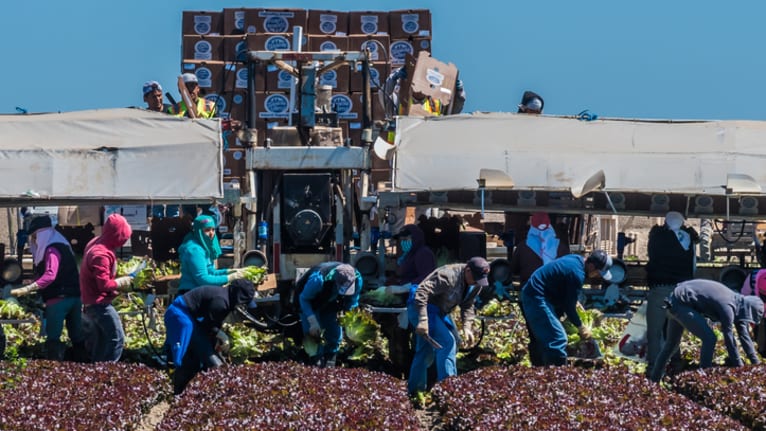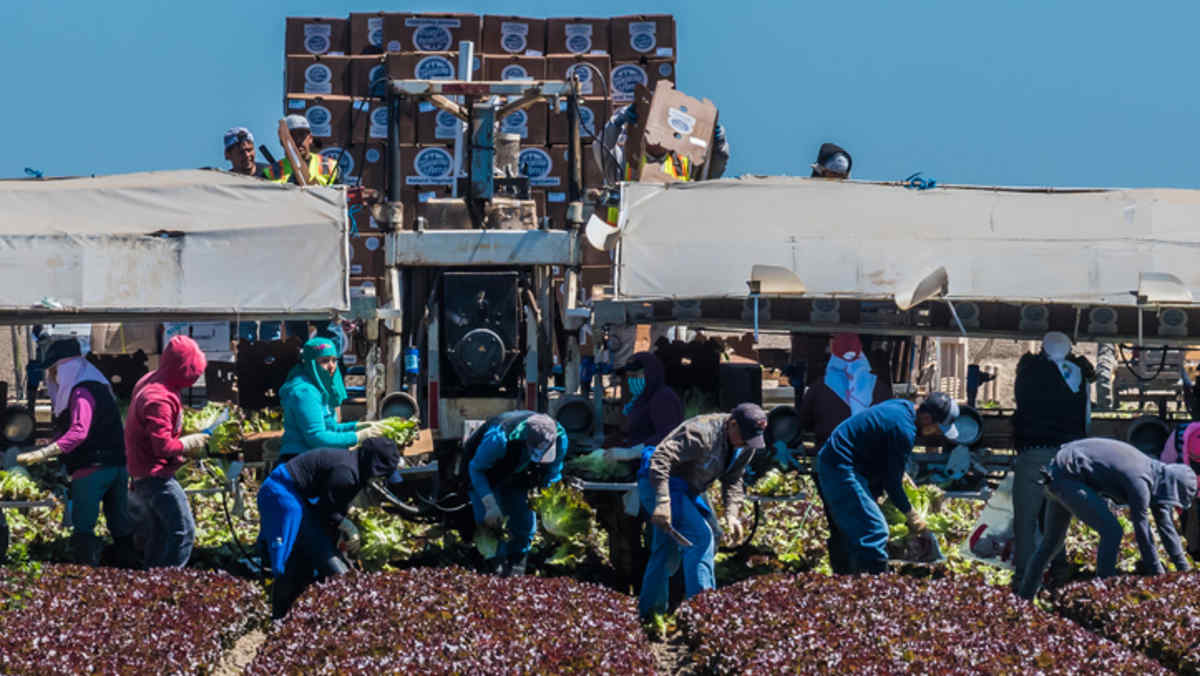

?The U.S. Department of Labor (DOL) issued new regulations amending the H-2A agricultural guestworker visa program, making changes to how prevailing wages are formulated, modernizing how the application and certification process is conducted, and improving standards for employment conditions.
The final rule—stemming from a proposed rule by the Trump administration in 2019—will go into effect Nov. 14.
DOL Secretary Marty Walsh said the updated regulations will strengthen protections for workers and simplify the H-2A application and temporary labor certification process for employers. The final rule will also enhance the DOL’s enforcement capabilities against program fraud and abuse, he noted.
The H-2A program allows agricultural employers to hire foreign guestworkers for up to three years for seasonal and temporary jobs. The program has no annual caps and has been steadily growing in recent years. The DOL issued more than 250,000 H-2A visas in fiscal year 2021, up from fewer than 60,000 a decade earlier.
“Employers for years have been looking for this program to be more flexible, streamlined and cost-effective, especially as it has continued to grow tremendously,” said Kristi Boswell, an attorney in the Washington, D.C., office of Alston and Bird, and former senior advisor at the U.S. Department of Agriculture, where she was part of the team that drafted the 2019 proposed rule.
Except for requiring electronic application filing, many of the provisions intended to make the program more flexible and effective were stripped out of the final rule issued by the Biden administration, Boswell said.
“The final rule shows that the DOL is focused on concerns about the treatment of workers, protection of the U.S. workforce and increased enforcement,” she said. But she added that there were several measures missing from the final rule which would have benefited employers, including:
- A flexible 14-day window for workers to start work to mitigate unpredictable circumstances like weather which can delay planting and harvesting. “Sometimes strawberries are not ready for picking on the predetermined day listed on the application,” Boswell said.
- The opportunity to file one application for multiple dates of entry within a 120-day period. Many farmers do not need their entire workforce at the very beginning of the season, and under current H-2A regulations, farmers have to file separate applications if they want to spread out the arrival of their employees, which requires additional time and fees spent on processing.
- The ability to request post-certification amendments to help farmers place workers where they are needed based on changing circumstances.
Key Provisions of the Final Rule
Mandatory e-filing. The DOL will require electronic filing of applications via a centralized online system, codifying what most employers already do by choice. Currently, nearly all employers file electronically since the option became available in 2019, but the new rule will eliminate the paper mail-in option except for employers that are unable or limited in their ability to use or access electronic forms as result of a disability or lack of access to e-filing.
This requirement is intended “to reduce costs and burdens for most employers, improve the quality of applications, reduce the frequency of delays associated with deficient applications, and better facilitate interagency data-sharing,” Walsh said.
Joint employment. The DOL will treat employers that operate jointly as such even if they don’t file H-2A applications together and broaden liability for all employers in the shared employment relationship. That would include farmers hiring labor contractors and employers applying for workers via an agricultural association.
“It’s a clear signal that the DOL wants to expand the responsibility to anyone participating in the program and will be investigating employment relationships more closely to make sure everyone is abiding by the rules,” Boswell said. “I think the rub for employers is that there are already a lot of protections in the program, and employers would rather the bad actors be punished for violations rather than broadening enforcement to everyone.”
On the other hand, the new rule permits a group of employers possessing the same need for agricultural labor to file a single application and job order to jointly employ workers in full-time employment.
“This provision is intended to provide small employers who cannot offer full-time work for their H-2A employees with an opportunity to participate in the H-2A program and ensure each employer will be held jointly liable for compliance with all program requirements,” Walsh said.
Boswell agreed that the provision is a positive step, especially for small growers who only need workers for a few days. “It’s challenging for small farmers to put in the capital needed for housing and visa processing, and this will allow these employers to share overhead costs and transfer workers among their farms.”
Housing standards and inspections. Employers must provide housing that meets federal safety standards or place workers in rental or public accommodations at no cost to H-2A workers.
Under current regulations, employers are required to obtain annual preoccupancy inspections of their housing before labor certification. This requirement can lead to delays in the labor certification process, given the high demand for inspections and the finite resources of the state workforce agencies that conduct the inspections.
The 2019 proposed rule would have allowed state agencies to inspect and certify employer-provided housing for up to two years, with employers conducting self-inspections of the housing during that time frame, Boswell said.
Employers and some state agencies expressed support for the measure, saying it would reduce delays in the certification process. Critics of the proposal stated that employer-provided housing often fails to meet health and safety standards, and that more inspections are needed—not fewer—especially when workers are placed in rental housing.
Overcrowding is one of the most common problems encountered when inspecting hotels or motels used to house H-2A workers, Walsh said. “Workers have been found to be required to share a bed, sleep on the floor in a sleeping bag, share a single room where as many as eight people may be sleeping, or sleep on mattresses on the ground. In addition, hotels and motels may not have sanitary facilities or adequate cooking equipment, which can lead to worker health issues, rodent or pest infestations, and fire hazards. Workers housed in hotels and motels also may not have access to laundry facilities, a serious concern for workers whose clothing regularly comes into contact with pesticides or herbicides.”
Expanded prevailing wage surveys. The rule codifies previous guidance issued to the state workforce agencies and expands the number of survey providers to include additional state sources such as colleges and universities, to encourage more prevailing wage survey findings. The prevailing wage is defined as the average wage paid to similarly employed workers in a specific occupation in the same area of employment.
The DOL has retained the requirement that employers seeking H-2A visas must pay the highest of the adverse effect wage rate (AEWR), the prevailing wage, the agreed-upon collective bargaining wage, or the federal or state minimum wage. The AEWR is the average hourly wage rate for field and livestock workers, as measured by the Department of Agriculture’s Farm Labor Survey.
“In reality, the vast majority of workers are getting paid the AEWR, which is typically the highest,” Boswell said. But prevailing wages are used in a few states, such as in the Pacific Northwest, where they can top the AEWR, she noted.
“Employers are worried that expanding who can conduct prevailing wage surveys will put the statistical validity of these surveys into question,” she said. “These are sophisticated surveys, and who will be making sure that they are being done accurately?”
A separate proposed rule issued by the Biden administration in December 2021 would change the way that AEWRs are calculated, basing them on wages paid to workers by occupation rather than geographic areas. The proposal reflects the DOL’s concern that the current AEWR methodology for field and livestock workers may have an adverse effect on the wages of workers in higher-paid agricultural occupations, such as supervisors and construction laborers.
The American Farm Bureau Federation has said that the proposed changes would make the H-2A program too costly for many smaller employers that rely on temporary guestworkers.
That proposal is still under review.

